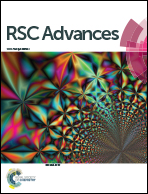The investigation of the electrochemically supercapacitive performances of mesoporous CuCo2S4†
Abstract
Ternary metal sulfides have been regarded as a promising class of electrode materials for high-performance supercapacitors since they can offer higher electronic conductivity and higher electrochemical activity than single-component metal sulfides. In this work, mesoporous CuCo2S4 nanoparticles have been prepared by a solvothermal route and utilized as supercapacitor electrode materials. The as-fabricated mesoporous CuCo2S4 nanoparticles exhibit a specific capacitance of 752 F g−1 at a current density of 2 A g−1, excellent rate capability with 47.9% of capacity retention from 2 to 100 A g−1, and good cycling stability with 98.1% of initial capacity retention and 90.1% of activated maximum capacity retention at a current density of 3 A g−1 for 5000 cycles. This superior electrochemical performance can be ascribed to the synergetic effect of the large specific surface area, superior mesoporous structure and high electronic conductivity. These results above render the as-fabricated mesoporous CuCo2S4 nanoparticles promising electrode materials for supercapacitors. Additionally, this facile and cost-effective preparation method can be extended to the fabrication of other ternary or even quaternary metal sulfides in the development of high-performance supercapacitors and other energy storage systems.


 Please wait while we load your content...
Please wait while we load your content...